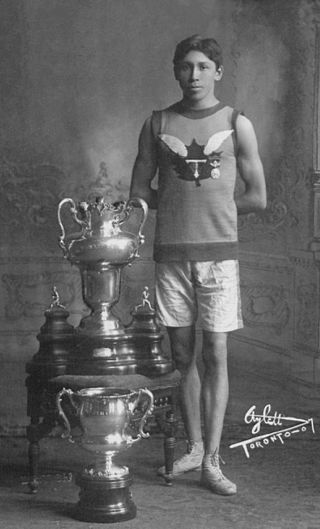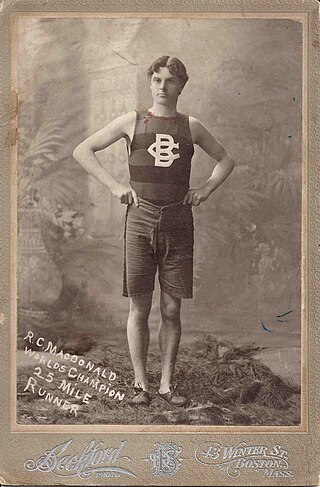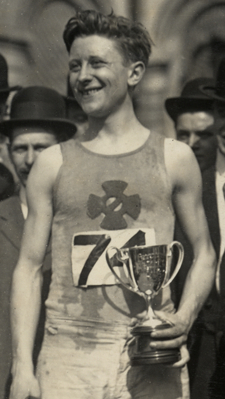

Thomas Patrick Morrissey (2 September 1888 - 1 October 1968) [1] was an American long-distance runner who won the Boston Marathon in 1908. [2]


Thomas Patrick Morrissey (2 September 1888 - 1 October 1968) [1] was an American long-distance runner who won the Boston Marathon in 1908. [2]
Tom Morrissey was born to Irish immigrants in 1888 at Yonkers, New York. His mother opened a boarding house after his father, a horse shoer, died a young man, leaving eight children, [3] and Morrissey left school after the eighth grade. [4]
Morrissey was a member of the Mercury Athletic Club that was established at Yonkers by Sammy Mellor. He entered the Boston Marathon four times between 1906 and 1909. In 1906 he finished in third place, but the next year finished only seventeenth. Later that year (1907) he won the national indoor 25-mile championship in New York and then placed tenth at the inaugural Yonkers Marathon. He had trained by running ten to fifteen miles every second day, walking on the other days. Every three weeks he ran a twenty-miler. [5] On March 24, 1908 he won an indoor 25-mile race in Brooklyn, New York "by a mile." [6]
One month after his Brooklyn race he entered the Boston Marathon for the third time. He was only in ninth place passing through the five-mile point at South Framingham, but worked his way through the field until he passed the leader, Robert Fowler, two miles from the finish line. His time was 2:25:43.2, the second fastest time ever on the course at that time after Tom Longboat's record the previous year. [5]
On the basis of his performance at the Boston Marathon, Morrissey was selected to represent the United States at the 1908 Olympic Games in London, where he entered the Marathon, but did not finish the event on a hot and humid day. [7]
In 1909 he entered the Boston Marathon for a final time, but began to walk at the Wellesley Hills (about the 13-mile point) on another hot and humid day, and dropped out of that race. [8] Morrissey then joined the professional ranks, and on May 6 participated in a Marathon Derby at the Polo Grounds in New York City featuring twelve prominent marathoners including Tom Longboat, Dorando Pietri, John Svanberg, Felix Carvajal, Fred Appleby, Fred Simpson, and Henri St. Yves, who won the race. Morrissey collapsed after seventeen and a half miles and had to be carried from the field. [9] He continued to enter professional races over the next two years without any notable successes.
In later life he joined the Yonkers Police force, [10] and worked his way up to the rank of captain. [4] He died in 1968 at the age of eighty at Yonkers.

This list is a chronological progression of record times for the marathon. World records in the marathon are now ratified by World Athletics, the international governing body for the sport of athletics.

Thomas John Hicks was an American track and field athlete. He won the marathon at the Olympic Games in 1904.

John Joseph Hayes was an American athlete, a member of the Irish American Athletic Club, and winner of the marathon race at the 1908 Summer Olympics. Hayes' Olympic victory contributed to the early growth of long-distance running and marathoning in the United States. He was also the first man to win a marathon at the now official standard distance of 26 miles 385 yards when Olympic officials lengthened the distance to put the finish line in front of the Royal Box.

The Yonkers Marathon, is a marathon race held annually in Yonkers, New York. Founded in 1907, it is the second oldest marathon in the United States, after the Boston Marathon. It is held on the third Sunday in October. In addition to the marathon, there is a half marathon race and a 5K course. At the end of the race there is a gathering and festivities centered on Van de Donck Park.

Thomas Charles Longboat was an Onondaga distance runner from the Six Nations Reserve near Brantford, Ontario and, for much of his career, the dominant long-distance runner. He was known as the "bulldog of Britannia" and was a soldier in the Canadian Expeditionary Force (CEF) during the First World War.

Ronald John MacDonald was a Canadian runner, best known as the winner of the second Boston Marathon, in 1898. He later became a successful physician in Nova Scotia.
Ellison Myers Brown, widely known as Tarzan Brown, a direct descendant of the last acknowledged royal family of the Narragansett Tribe of Rhode Island, was a two-time winner of the Boston Marathon in 1936 (2:33:40) and 1939 (2:28:51) and 1936 U.S. Olympian. He ran the marathon in the 1936 Summer Olympics in Berlin and also qualified for the 1940 Summer Olympics, which were ultimately canceled due to the outbreak of World War II.

Sidney Herbert Hatch was an American athlete who competed for the United States in the 1904 Summer Olympics held in St. Louis, United States, in the 4 mile team where he won the silver medal with his teammates James Lightbody, Frank Verner, Lacey Hearn and Frenchman Albert Corey.

Richard Grant was a Canadian track and field athlete who competed at the 1900 Summer Olympics in Paris, France for the United States. He also competed in the first four Boston Marathons, one of only two athletes to have done so.

Harry James Smith was an American long-distance runner. He was most notable for competing in the 1912 Olympics in Stockholm. He was also the father of Hart wrestling family matriarch Helen Hart and the father-in-law of Stu Hart.

Michael J. Ryan was an American track and field athlete and a member of the Irish American Athletic Club. He was a distance runner and competed in the marathon for the U.S. Olympic team in the 1908 Summer Olympics and 1912 Summer Olympics, but did not finish either race.

Roberta Louise Gibb is an American former runner who was the first woman to have run the entire Boston Marathon (1966). She is recognized by the Boston Athletic Association as the pre-sanctioned era women's winner in 1966, 1967, and 1968. At the Boston Marathon, the pre-sanctioned era comprised the years from 1966 through 1971, when women, who under AAU rules could not compete in the Men's Division, ran and finished the race. In 1996 the B.A.A. retroactively recognized as champions the women who finished first in the Pioneer Women's Division Marathon for the years 1966–1971.
Robert Arthur Fowler was a Newfoundland-born long-distance runner who was recognized by the International Association of Athletics Federations as having set a world's best in the marathon on January 1, 1909 with a time of 2:52:45.4 at the Empire City Marathon in Yonkers, New York.
Samuel Alexander Mellor Jr. was an American long-distance runner who won the 1902 Boston Marathon and competed in the marathon at the 1904 Summer Olympics in St. Louis, Missouri.
John J. McDermott was an Irish-American athlete. Nicknamed "J.J." or "little Mac", he won the first marathon run in the United States in 1896, as well as the inaugural Boston Marathon, then known as the B.A.A. Road Race, in 1897. He was a lithographer by trade.
John Charles Lordan (or Lorden) (born June 30, 1874, or June 29, 1876, died February 12, 1960) was an American long-distance runner who won the 1903 Boston Marathon and competed in the marathon at the 1904 Summer Olympics in St. Louis, Missouri.

Lawrence Joseph Brignolia, sometimes Brignoli, was an American long-distance runner and sculler of Italian descent. He won the third running of the Boston Marathon, in 1899. A 161-pound (73 kg) blacksmith, he remains the heaviest person ever to claim victory in the event. He was the only runner to finish each of the first three Boston Marathons, and one of two runners who participated in each of the first four.

John Duncan Semple was a Scottish-American runner, physical therapist, trainer, and sports official. In 1967, he attained worldwide notoriety as a race official for the Boston Marathon, when he repeatedly assaulted 20 year old marathon runner Kathrine Switzer and knocked down her coach when he tried to protect her. Switzer was officially entered in the race in accordance with the Boston Marathon's rule book which at that time made no mention of sex. Semple subsequently claimed that amateur rules banned women racing for more than 1.5 miles (2.4 km). He subsequently oversaw implementation of qualifying times in 1970 and, in response to lobbying and rule changes by the Amateur Athletic Union (AAU), the implementation of a separate women's race in 1972.

Timothy Ford was an American long distance runner who won the Boston Marathon in 1906. At the age of eighteen, he is the youngest person ever to have won that race.

The 1898 Boston Marathon, contemporarily referred to as the Boston Athletic Association's annual marathon race, was the second edition of the marathon race that became known as the Boston Marathon. It took place on April 19, 1898, from Ashland to Boston, Massachusetts, over a distance of 24.5 miles (39.4 km).